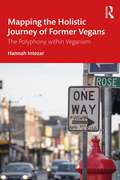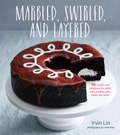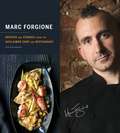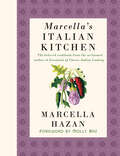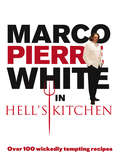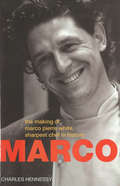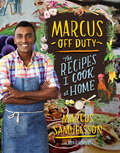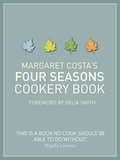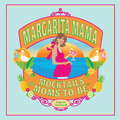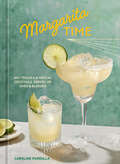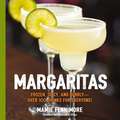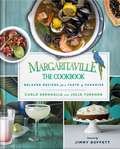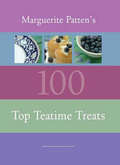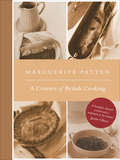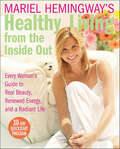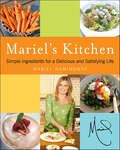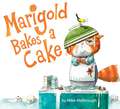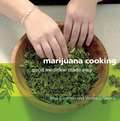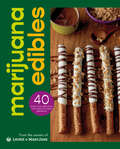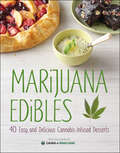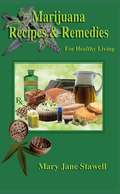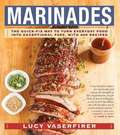- Table View
- List View
Mapping the Holistic Journey of Former Vegans: The Polyphony within Veganism
by Hannah IntezarThis book explores Veganism through the holistic journeys and lived experiences of former vegans, with a particular focus on the impact this has on their Selfhood and identity. It delves into the complexities underpinning definitions of Veganism and vegan identities.Based on original qualitative research charting the experiences of ten former vegans, the text offers a theoretical lens for understanding evolving self-perception, identity, and experience, exploring what leads to initiating a transition in and out of Veganism and how former vegans reconcile with losing their vegan identity. Applying a Bakhtinian model of Selfhood, this book explores the tensions between ‘Voices’ representing values within social discourse, such as Veganism, and how individuals co-construct their identity and self-perception through said Voices. Chapters explore the Polyphony within Veganism and offer an insight into the embodied experience of former vegans. Each analysis chapter has been divided into three distinct Threshold-moments of beginning, middle, and end.Mapping the Holistic Journey of Former Vegans: The Polyphony within Veganism is intended for scholars and postgraduate students interested in Veganism, Selfhood and identity, and behaviour change and anyone looking to understand the context of Veganism in practice.
Maravilhosas Receitas de Limonada Para Dar Sede!
by Amber Richards Hamíreths CostaMaravilhosas Receitas De Limonada De Dar Sede! De bebidas clássicas a bebidas modernas com ervas e misturas temperadas. Se você está desfrutando de uma noite relaxante, aproveitando uma bebida mais forte ou cítrica, ou tomando uma refrescante copo de limonada clássica em uma tarde quente, este e-book contém 42 receitas de limonada incríveis para saciar a sua sede. Aproveite o poder de limpeza natural do suco de limão com receitas criativas que toda sua família irá desfrutar, perfeito para receber convidados, com toque único naquela famosa limonada que todos amam. Descubra os benefícios para saúde e antioxidantes que curam encontrados nas bebidas de limão geladas e quentes para aproveitar durante o ano. Não só elas podem saciar a sua sede, como também podem ajudar na cura de dores de garganta e dar um impulso rápido no sistema imunológico para combater gripes e resfriados. Desfrute de misturas ricas, de bebidas temperadas e ervas medicinais a deliciosas limonadas de frutas. Você com certeza vai saborear o gosto fresco e refrescante de limão natural, com cada receita que vai descobrir. Baixe o seu e-book agora mesmo para descobrir a sua próxima nova bebida favorita.
Marbled, Swirled, and Layered: 150 Recipes and Variations for Artful Bars, Cookies, Pies, Cakes, and More
by Irvin Lin&“Filled to the brim with recipes for the most splendidly beautiful cakes, cookies, breads, and tarts I think I&’ve ever seen . . . a triumph!&” —Ree Drummond, &“The Pioneer Woman&” Incredible desserts with layers and swirls of flavor that are beautiful and delicious—inside and out When you marble, layer, and swirl doughs, batters, toppings, or frostings, good looks and good taste come together in one total package. Irvin Lin, creator of the popular blog Eat the Love, shows how these techniques open the door to inventive flavor combinations that look as fantastic as they taste. Bakers of all levels will enjoy recipes ranging from easy brownies and bars to brunch-worthy muffins and morning buns to show-stopping cakes and tarts: cinnamon spiral icebox cookies, pistachio-swirl brownies, triple-chocolate pie, multicolored &“Neapolitan&” layer cake, and more. Lin offers variations to suit any taste (more than 150 recipes total) plus baking and decorating tips throughout on topics like making your own all-natural food coloring, rolling up jelly roll–style cakes, and discovering the magic of browned butter. Readers (and eaters) are sure to ooh and ahh over every dazzling dessert at first glance—and then again at first bite. &“Irvin Lin gives home-baked treats a twist, ramping them up with a range of contemporary flavors that are sure to surprise and delight.&”—David Lebovitz, New York Times bestselling author of Drinking French &“Leave it to Irvin to hit it out of the park with Marbled, Swirled, and Layered. Every recipe is an inspiration! I want to make, and eat, every. single. one.&”—Elise Bauer, founder of Simply Recipes
Marc Forgione
by Olga Massov Marc ForgioneChef Marc Forgione opened his eponymous New York City restaurant in 2008 to widespread acclaim, becoming the youngest American-born chef and owner to receive a Michelin star in consecutive years. Upon winning Season 3 of Food Network's The Next Iron Chef, Forgione joined the ranks of former and current stars and best-selling authors such as Mario Batali and Bobby Flay. He can now be seen competing as one of the stars of the beloved Iron Chef America. Forgione's first cookbook features gorgeous photos throughout and 170 recipes with restaurant signature favorites including Chili Lobster and Chicken Under a Brick. The cookbook features not only recipes but also stories of an unlikely journey to where Chef Forgione and the restaurant are now. Flavor comes first, but Forgione is like an artist in the way he presents food. His goal with the book is not to just present a collection of recipes but to challenge home cooks and aspiring chefs, helping them to elevate their skills in the kitchen.
Marcella's Italian Kitchen: A Cookbook
by Marcella HazanA personal cookbook from the James Beard Foundation Lifetime Achievement Award-winner and best-selling author that captures every aspect of Italian home cooking—from appetizers to ice cream. • &“It&’s almost as good as a trip to Italy!&” —New York magazineIncluding almost 250 recipes, Marcella&’s Italian Kitchen brings home cooks the authentic tastes of Italy. Here are Fettuccine with Clams and Zucchini and Veal Scaloppini with Hazelnuts and Balsamic Vinegar, Cauliflower Salad with Red Pepper, Olives, and Anchovies and Amaretti and Custard Cream Semifreddo. Drawing on her experiences growing up in Italy, Hazan has crafted the ultimate guide to Italian food.
Marco Pierre White in Hell's Kitchen: Over 100 wickedly tempting recipes
by Marco Pierre WhiteLong before Gordon Ramsay and Antony Bourdain, there was Marco Pierre White: the first and the greatest enfant terrible of the cookery world. His book, White Heat, caused a sensation on publication in 1990. Now Marco puts his chef's whites back on and returns to the kitchen for the first time in years as he puts the celebrities through their paces on this exciting and enduringly popular television show, moving into its third series. The colourful chef, as famous for his ability to make headlines as for making headturning dishes, serves up 100 delicious recipes in this mouthwatering cookery book. Alongside the wonderful recipes - ranging from partridge pie with creamy wild mushroom sauce to melting chocolate souffle with vanilla cream - come shortcuts, masterful tips and tricks of the trade. Marco Pierre White is a natural for television and this fully illustrated book allows his talents to shine. Use this book at home and you'll have a taste of what it's like to cook in the company of a culinary genius.
Marco Pierre White: Making of Marco Pierre White,Sharpest Chef in History
by Charles HennessyMarco was born of working-class parents on a bleak council estate in Leeds, and his Italian mother died when he was six years old. Today he has become a star chef of international renown, a controversial media celebrity, a national icon of the 1980s and 1990s, and a multimillionaire entrepreneur - all before the age of 40. How has this staggering rise to fame and fortune been achieved? MPW (as he calls himself and many of his new restaurants) is today widely regarded as the best cook in the country, but his astonishing talents and understanding of food are only part of the explanation. As this fascinating book reveals, there are many sides to this complex man which the massive media coverage he has received over the years have never revealed. Charles Hennessy tells the story with insight: the unpromising early life, his first job as a kitchen porter in Harrogate, the epiphany at the age of 17 when he went to work at the Box Tree restaurant in Ilkley, his arrival in London, learning under the Roux brothers, Pierre Koffmann and Raymond Blanc, and the opening of his own first restaurant, Harvey's from whence his fame and fortune grew.
Marcus Off Duty: The Recipes I Cook at Home
by Roy Finamore Marcus SamuelssonUnwind with 150 relaxed, multicultural dishes from the award-winning celebrity chef and New York Times–bestselling author! Born in Ethiopia, raised in Sweden, and trained in European kitchens, Marcus Samuelsson is a world citizen turned American culinary icon—the youngest chef ever to receive three stars from the New York Times, a five-time James Beard Award recipient, a winner of Top Chef Masters, and a judge on Chopped. He was even chosen to cook President Obama&’s first state dinner. In Marcus Off-Duty, the chef former president Bill Clinton says &“has reinvigorated and reimagined what it means to be American&” serves up the dishes he makes at his Harlem home for his wife and friends. The recipes blend a rainbow of the flavors he has experienced in his travels: Ethiopian, Swedish, Mexican, Caribbean, Italian, and Southern soul. With these recipes, you too can enjoy his eclectic, casual food—including Dill-Spiced Salmon; Coconut-Lime Curried Chicken; Mac, Cheese, and Greens; Chocolate Pie Spiced with Indian Garam Masala; and for kids, Peanut Noodles with Slaw . . . and much more. &“Highly recommended for adventurous and well-traveled home cooks, as well as fans of Susan Feniger&’s Street Food.&” —Library Journal
Margaret Costa's Four Seasons Cookery Book
by Delia Smith Margaret CostaHundreds of recipes to take you through winter, spring, summer, and fall: “A book no cook should be able to do without.”—Nigella Lawson This volume brings the cycles of nature back to the kitchen. It is written for people who care about eating well by using fresh foods in season—and about feeding their families with good meals that are neither elaborate nor time-consuming. Whether it’s cold soups for summer or Dutch Apple Squares for an autumn treat, this book offers an extensive collection of recipes organized by the seasons as well as by featured ingredients.
Margarita Mama
by Alyssa GusenoffCelebrate Maternity--With a Refreshing Materni-tini! From Watermelon Margaritas and Pineapple Mojitos to Mai Tais, Mimosas, and Cosmopolitans, Margarita Mama offers a pitcherful of delicious "mocktails" designed specifically for moms-to-be. These tasty treats are 100 percent alcohol-free and offer plenty of nutritional benefits for both mom and baby. Recipes include twists on old favorites such as Mudslides, Piña Coladas, and Sangria, plus yummy new libations like the Raging Hormone, the Nothing Fits Fizz, and the Perfect Pear of Jeans. Filled to the brim with delicious concoctions and whimsical illustrations, Margarita Mama makes the perfect gift for fun-loving moms-to-be everywhere.
Margarita Time: 60+ Tequila & Mezcal Cocktails, Served Up, Over & Blended
by Caroline PardillaA bright and splashy tribute to the iconic cocktail, with more than 60 recipes for margaritas on the rocks, served up, and even frosty blended versions, from mixologists across the globe.The margarita has long dominated as America's favorite cocktail, be it for happy hour, brunch, or Margarita Monday. It's liquid vacation, sunshine in a glass, fuel for festivities. Margaritas now populate grocery store aisles in ready-to-drink cans, and bartenders can attest that this classic cocktail continues to be a bestseller. Margarita Time showcases beloved, straightforward versions of the margarita as well as elevated, approachable, and crafty riffs created by established bartenders from revered bars and restaurants. The bartenders also share their favorite tequilas along with the margarita they make for themselves. The introduction includes a history of the drink's origins, as well as guidance on ingredients to buy and suggested bottles for stocking the home margarita bar.Margarita Time celebrates the margarita in all its forms, including recipes for:Starting Simple: Tommy's Margarita, Mezcal Margarita, and Ranch WaterMarg Mash-Ups: Mexican Martini and Oaxacan SunsetFrozen: Summer Melon Margarita and Frozen JägeritaFruity Riffs: Super Strawberry Marg and Black Forest MargaritaVeggie Variations: Spa Day Margarita and Margarita Verde Spiced & Spicy: Picante Amante and Margarita al PastorIconic Iterations: Salt Air Margarita by Chef José AndrésAnd many more!Margarita Time leads us on an adventurous cocktail tour through a panoply of recipes starring this classic cocktail.
Margaritas: Frozen, Spicy, and Bubbly - Over 100 Drinks for Everyone! (Mexican Cocktails, Cinco de Mayo Beverages, Specific Cocktails, Vacation Drinking) (The Art of Entertaining)
by Mamie FennimoreAdd a citrusy twist to your gatherings and parties with this collection of recipes to shake up your margarita game!Frozen, neat, or on-the-rocks, Margaritas is the ultimate margarita handbook that will help you step up your cocktail game and features:Over 101 recipes for making perfect margaritasA guide to all types of tequilaA history of this citrusy cocktail&’s Mexican origins and its journey to the United States and the rest of the worldNecessary glasses and tools for every home barFull-color photography enhances the experience of this bookThis cocktail book features creative garnishes that provide plenty of ways to serve this party favorite as well as recipes for delicious mocktails to satisfy the taste of everyone. Margaritas is the perfect addition to any cocktail lover's collection.
Margaritaville: Relaxed Recipes For a Taste of Paradise
by Jimmy Buffett Julia Turshen Carlo Sernaglia Bj BertiSavor the taste of paradise with Margaritaville: The CookbookWarm sun, cool drink, and nowhere to be—that’s Margaritaville! It’s a celebration of relaxation and an invitation to enjoy good food and good company. Margaritaville: The Cookbook is filled with recipes that bring the flavor of island living and the spirit of Jimmy Buffett's iconic song straight into your home. The first official cookbook from the beloved world of Margaritaville features laid-back favorites like the explosively good Volcano Nachos and the heaven-on-earth-with-an-onion-slice Cheeseburger in Paradise, alongside more sophisticated options that will wow your guests (Coho Salmon in Lemongrass-Miso Broth, anyone?). With its combination of recipes, stories, and gorgeous full color food and lifestyle photographs throughout, it is sure to put you in a Margaritaville state of mind! Margaritaville isn’t confined to single spot on the map -- the recipes draw inspiration from around the world, from Jerk Chicken to Tuna Poke with Plantain Chips and Jimmy’s Jammin’ Jambalaya. And we've got you all covered, from family-friendly Aloha Hotdogs to drool-worthy Vegetarian Burgers.It's 5 o'clock somewhere and no vacation is complete without a cocktail—preferably a margarita, of course! Margaritaville: The Cookbook is loaded with drink recipes to inspire your blissful island cocktail hour—from Jimmy's Perfect Margarita and Paradise Palomas to Cajun Bloody Mary's and the quintessential Key West Coconut and Lime Frozen Margarita.
Marguerite Patten's 100 Top Teatime Treats
by Marguerite PattenEngland&’s premier food maven shares recipes for cakes and dainties designed to make teatime sparkle. Only the most hardened dieter can resist the pleasures of afternoon tea. Its enjoyment, whether it is a simple slice of home-baked cake or dainty sandwiches followed by scones oozing with jam and cream, is part of our culture and is a tradition acted out each and every day in tea-rooms up and down the country. This then is the perfect book for all tea-time lovers, with over 100 recipes chosen by the un-crowned queen of British cookery, Marguerite Patten, and is published as a tribute to and celebration of Marguerite&’s 90th year. There are recipes for cakes, breads, biscuits, sandwiches, and savories from England, Scotland, Wales, and Ireland as well as recipes from teatimes around the world. But teatime isn&’t teatime without a pot of tea, so the book also traces the history of Britain&’s national beverage with a guide to all the different blends and styles available.
Marguerite Patten's Best British Dishes
by Marguerite PattenThe cookery queen of England selects her personal favorite recipes. Marguerite Patten is one of Britain&’s best known and best loved cookery writers. Here she turns her attention to one of her real true passions: the classic cookery of the British Isles. From traditional breakfasts to high teas, from roasts to hearty soups, she has selected a collection of over 400 of her favorite recipes showing the enormous and exciting variety of British produce and cooking. She covers soups, fish dishes, meat, poultry, and game, vegetables, salads, and savory dishes as well as puddings, baking, and preserves.
Marguerite Patten: A Century of British Cooking
by Marguerite PattenBritain’s beloved first minister of food offers a decade-by-decade survey of the rich culinary traditions of her home country. Marguerite Patten OBE has written over 160 cookery books, sales of which amount to over 16 million worldwide. Her long and distinguished career, which began before the war, has included regular appearances on radio and television, live and televised cookery demonstrations, lectures as well as extensive journalism and authorship of books and cookery cards. Marguerite is one of Britain’s best known and loved cookery writers and has often been described as England’s Cookery Queen. Ainsley Harriott dubbed her “the cookery icon of our times.” Her Century of British Cooking pulls together her life’s work, with over 200 recipes, and is truly an important work of culinary history. Each chapter covers one decade of the twentieth century, giving both history and recipes. The entire book is illustrated throughout in color and black-and-white. “This book is a marvelous survey of how much and how fast a food culture can change. I do encourage you to pick up a copy for the details from 1950 on. It’s a fascinating story, and it just may make you appreciate living in the here and now.” —Cooking by the Book
Mariel Hemingway's Healthy Living from the Inside Out: Every Woman's Guide to Real Beauty, Renewed Energy, and a Radiant Life
by Mariel HemingwayCelebrity, author, yoga instructor, and wellness enthusiast Mariel Hemingway offers a 30-day plan for total mind and body health Mariel Hemingway’s Living in Balance is not another one-size-fits-all program with rigid rules and baffling instructions. Rather, the simple steps in this practical program to all-over wellness springs from four fundamental areas of life: food, exercise, silense, and environment. Hemingway, a longtime yoga devotee and one of the leading voices for holistic living, discusses what our bodies and minds need, how to make the best decisions for our daily lives, and why in just 30 days we can all look great, feel great, and find peace of mind. Readers learn:• How what we eat and drink affects how we feel every day. • That exercise not only helps us stay in shape, but connects us to ourselves• How bringing silent reflection into our lives helps us learn to observe, and can positively alter our habits and behaviors.• Why our homes echo the clutter and chaos of the outside world, and how they can be transformed into havens for the balanced life we seek.
Mariel's Kitchen: Simple Ingredients for a Delicious and Satisfying Life
by Mariel HemingwayHow do you cook nutritious and delicious meals when life is busy and time is short? How can you make fresh, organic food a part of your and your family's way of life—simply and affordably? These are the questions that Mariel Hemingway answers by sharing tried-and-tested recipes, straight from her kitchen to yours.Filled with exciting, beautiful photographs and easy-to-follow instructions, Mariel's Kitchen includes seventy-five sensational recipes that can be mastered by anyone, regardless of cooking experience. Arranged according to the seasons, these recipes show how simple it can be to put locally grown, seasonal produce on your table in place of packaged and processed foods. From sublime summer breakfasts to delectable desserts and heartwarming winter dinners, these tasty dishes, snacks, salad dressings, marinades, and drink recipes put homemade eating back into easy reach.Mariel also shares her secrets that make it possible to eat well all week long, even with a full schedule. She reveals what staples are necessary for any pantry and how to prepare core recipes that become the foundation for multiple dishes. She offers shopping tips for navigating the world of organic and sustainable foods. And as she reveals what makes her kitchen “the heart of her home,” she peppers recipes with stories about her own lifelong love affair with food.Combining Mariel's no-nonsense attitude with wholesome recipes for every occasion, Mariel's Kitchen is a new kind of American cookbook designed to help you—and all those you cook for—eat better, fresher, and more delicious foods, day in and day out.
Marigold Bakes a Cake
by Mike MalbroughFor fans of Mo Willems' Don't Let the Pigeon... series. Baking the perfect cake is how Marigold spends Mondays. Being messy, noisy, and disruptive in Marigold's kitchen are how one finch, two pigeons, and three loons spend their Mondays!Marigold the cat loves Mondays, for that is when he bakes cakes! With his favorite recipe in front of him, he rolls up his sleeves and gets down to it. He whips up egg whites . . . Easy. He adds a cup of milk . . . Peasy. Then he sprinkles in just a pinch of . . . of finch?! That's not right at all! Neither are the smidgeons of pigeons or the spoonsfull of loons. Clearly a chase is in order! Yet all that leads to is a spectacularly messy kitchen. And no cake.With a recipe comprised of equal parts humor and charm, author-illustrator Mike Malbrough has cooked up a scrumptious laugh-out-loud addition to the great tradition of interruption books. Perfect for fans of Mo Willems' Don't Let the Pigeon Drive the Bus and David Ezra Stein's Interrupting Chicken.Praise for Marigold Bakes a Cake"This book contains the perfect recipe for fun. The watercolor illustrations are impeccable. . . This humorous book would be ideal for a storytime reading."--School Library Journal"Malbrough&’s watercolor illustrations are full of charmingly zany details, from dapper Marigold&’s polka-dot bow tie to the chocolate splatters after the birds take over the cake making, and the creatures&’ over-the-top facial expressions amp up the comedy. Playful rhymes and surprising page turns make this a great pick for a group storytime, and the comical ending . . . will be a valuable one for kiddos."--Booklist"Debut talent Malbrough celebrates the act of culinary creation and the joy of being absorbed in a personal passion—and, like the best desserts, he doesn&’t let his story get too sweet. In one of many lovely watercolor spreads, Marigold blends glossy curls of shaved chocolate and a ribbon of molasses into the batter. . . Doing what one loves, Malbrough shows, makes it possible to transcend even the basest instincts."--Publishers Weekly"Clever text follows the illustrations around the page, swirling with chocolate shavings and molasses as Marigold mixes his batter. The lush, textured watercolors match the energy of the story . . . Kids will giggle over the antics of both cat and birds during readalouds and will find plenty of humorous details to discover in the illustrations on their own."--BCCB
Marijuana Cooking
by Veronica Green Bliss CameronIn Marijuana Cooking: Good Medicine Made Easy, authors Bliss Cameron and Veronica Green guide would-be chefs through the process of making their own tasty and healthy home-remedies using marijuana. Step-by-step instructions and photographs carefully document the cooking techniques described, making this the most user-friendly marijuana cookbook available.Increasing awareness of the therapeutic properties of marijuana--to ease tension in the body, relieve pain and pressure, promote appetite, and induce overall relaxation--has generated widespread interest in its use as a medicine. Without doubt, the best and safest medicinal application of marijuana is ingestion.What makes this book truly unique is the careful attention paid to the individual needs of those who rely on the therapeutic properties of marijuana. The authors offer five ways to prepare marijuana for use in the kitchen, advice on personalizing dosage, and tips on substituting ingredients to account for different tastes and medical conditions.Cameron and Green understand that marijuana is good medicine for both the body and spirit. They have long been involved in providing healthy marijuana treats to individuals suffering from ailments such as arthritis, asthma, insomnia, appetite loss, and glaucoma, and others who rely on the soothing and therapeutic benefits of marijuana.
Marijuana Edibles: 40 Easy & Delicious Cannabis Confections
by Laurie Wolf Mary ThigpenMake your own marijuana-based desserts, candies, and sweet-and-salty treats! Eating or ingesting marijuana rather than inhaling it gives a longer, more-powerful high, spares your lungs, and allows you to partake in private. This makes it perfect for patients who need steady relief from pain, or for those who just want to add marijuana to food for enjoyment. Marijuana Edibles demystifies the edibles cooking process, covering the most popular extraction methods and helping you make your own delicious cannabis-infused edibles at home. Here&’s what you&’ll find in this fun and fascinating cookbook: · Recipes for 40 different perfectly-dosed, delicious treats—each featuring beautiful photography · Recipes ranging from cookies and bars, to chocolates, truffles, cakes, and frozen treats, including several vegan and gluten-free options · Tips on the equipment you&’ll need to make your infusions, with detailed guidance on how to decarb your cannabis and how to calibrate your infusions · Instructions for cooking with infusions and for making simple, single-serving edibles for quick ingestion
Marijuana Edibles: 40 Easy and Delicious Cannabis-Infused Desserts
by Laurie Wolf Mary ThigpenMake your own marijuana-based desserts, candies, and sweet-and-salty treats! Eating or ingesting marijuana rather than inhaling it gives a longer, more-powerful high, spares your lungs, and allows you to partake in private. This makes it perfect for patients who need steady relief from pain, or for those who just want to add marijuana to food for enjoyment. Marijuana Edibles demystifies the edibles cooking process, covering the most popular extraction methods and helping you make your own delicious cannabis-infused edibles at home. Here&’s what you&’ll find in this fun and fascinating cookbook: · Recipes for 40 different perfectly-dosed, delicious treats—each featuring beautiful photography · Recipes ranging from cookies and bars, to chocolates, truffles, cakes, and frozen treats, including several vegan and gluten-free options · Tips on the equipment you&’ll need to make your infusions, with detailed guidance on how to decarb your cannabis and how to calibrate your infusions · Instructions for cooking with infusions and for making simple, single-serving edibles for quick ingestion
Marijuana Recipes and Remedies for Healthy Living
by Mary Jane StawellMarijuana is a palliative, an analgesic with anti-inflammatory properties --it alleviates pain without addictive effects experienced with narcotics. You might think of marijuana as being something like an herbal aspirin. <P><P>In fact, it was used in folk medicines like aspirin for thousands of years to soothe aches and pains before aspirin was discovered. When hearing marijuana most of us call up an image of recreational smoking to "get high". Being in the high-state actually promotes wellness. Being high feels good and feeling good encourages healing and homeostasis.Most of us, however, are less familiar with the other ways in which one can use marijuana as a remedy for aliments that diminish quality of life-like aching muscles from over exertion or spinal misalignment, for example. Actually the list of aliments that can be soothed with medical marijuana is quite long. It is important to emphasize that marijuana does not "cure"; rather it soothes and alleviates and in so doing we feel better and heal faster. This comes from its palliative qualities.Marijuana's palliative qualities can be delivered in a variety of ways: smoking, eating, rubbing into the skin. Each of these delivery methods has special benefits, which are compared and contrasted in MARIJUANA RECIPES AND REMEDIES. In addition to the delicious foods described, MARIJUANA RECIPES AND REMEDIES tells how to extract the beneficial chemicals from the herb-its essence-to make tinctures and ointments good for massaging aching muscles, soothing bug bites.MARIJUANA RECIPES AND REMEDIES offers many easy, delicious, nutritious recipes, including desserts of all kinds, breads, main courses, and elixirs. It also teaches principles-such as using butter to extract the essence-so that you can experiment with your own recipe development. What fun!Most cookbooks tell you how to cook "from scratch", which is great if you're a cook and you have enough time. But many us aren't "cooks"-yet we would like to incorporate marijuana herbals in our menu. MARIJUANA RECIPES AND REMEDIES is unique in that it shows how to use inexpensive, off-the-shelf, ready-made mixes you can find at the corner store to make some fabulous cannabis cuisine. How to convert off-the-shelf lotions into something fit for Cleopatra-well, almost!
Marilu Henner's Total Health Makeover
by Marilu HennerWhen Was The Last Time You Felt Really Healthy?Now's the time to create the healthy, balanced life you want -- and become the truly vibrant, happy person you were meant to be. Combining good humor with solid science, Marilu Henner provides essential information on every aspect of health and fitness, including:Detoxing your bodyPreventing or alleviating health conditions from obesity to cancerThe secrets of stress reductionReal food and the organic way to fuel your bodyFree yourself forever from diets and disease-causing toxins, boost your energy, lower and maintain your weight -- and change your life.
Marinades
by Lucy VaserfirerThe tremendous success of slow-cooker cookbooks is rooted in the demanding lifestyles of working families: You get dinner started before you go to work and have it ready shortly after you return. Slow-cooking is not the only way to cook fabulous food on a busy schedule. Lucy Vaserfirer's Marinades offers a delicious alternative. With the right marinade, you can dress up meats, chicken, fish, or vegetables in the morning, pop the food in the fridge for the day, and finish it all off with a quick broil, grill, microwave, or sauté when you get home. Dinner is served! Vaserfirer, who previously has written Seared to Perfection and Flavored Butters, and also writes the blog Hungry Cravings, is a culinary-school instructor known for her expertise with meats, her knowledge of kitchen science, and her warm and engaging teaching voice. Marinades shows when to use--and not use--oil- based, vinegar-based, fruit-based, and milk- or cream-based marinades. The recipes range from comforting American, French, and Italian marinades to adventuresome and assertive ideas from Mexico and Latin America, Asia, and beyond. The book includes seventeen recipe chapters, nine of which are based on specific types of marinades (herb, spice, and citrus, for example) and eight of which range geographically across the world's best cuisines. Each of the 200 marinades is accompanied by an additional recipe that shows one way to use it. A Raspberry-Zinfandel Marinade, for example, features a recipe for Grilled Raspberry- Zinfandel Pork Medallions, while a Souvlaki Marinade has a recipe for Swordfish Souvlaki alongside. In keeping with the popularity of marinades among outdoor cooks, more than half of these 200 additional recipes are for grilled dishes, but there are ideas aplenty for indoor cooking as well.
